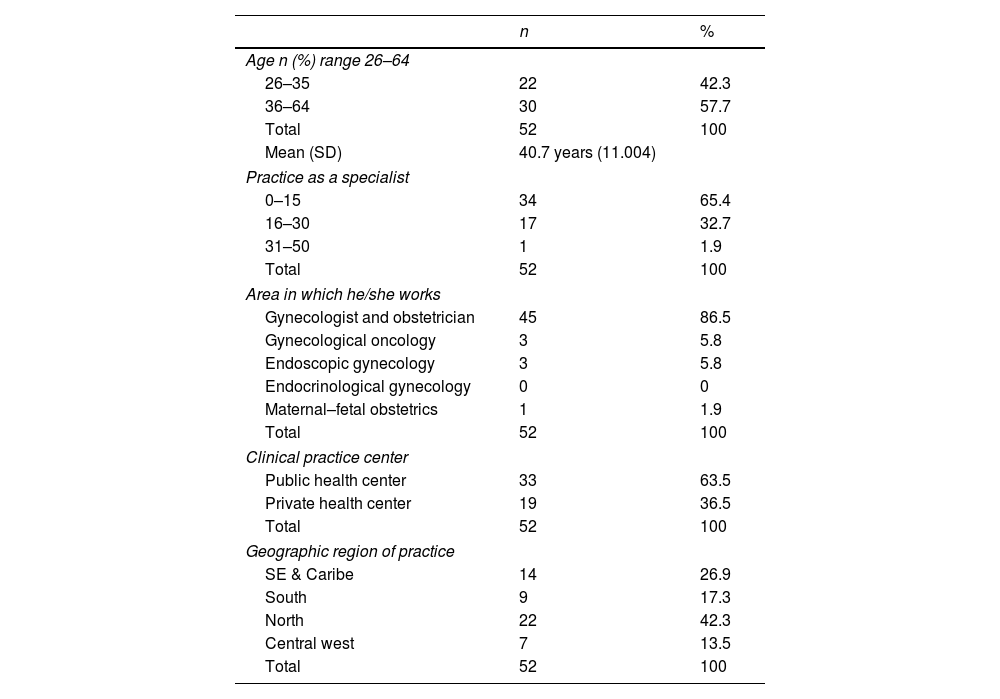Ovarian cancer is the fifth deadliest cancer among women. There is no effective screening method. It has been suggested that ovarian cancer originates from precursor lesions in the fimbriae of the fallopian tubes.
ObjectiveThe aim of this study was to determine the level of knowledge of opportunistic bilateral salpingectomy by gynecologists.
MethodsA cross-sectional study was carried out and a survey was sent electronically to gynecologists and gynecology residents. Demographic characteristics as well as questions of interest related to clinical practice and indication for surgery were included.
Results52 subjects were included, 21 women and 31 men, with a mean age of 40.7 years. Thirty-five board certified gynecologists, as well as 17 gynecology residents, were included as part of the total survey group. Thirty-six individuals (69.2%) reported performing elective salpingectomy. The motivation they had to perform salpingectomy as a method of sterilization was: “reduction in the risk of ovarian cancer in the future” (55.6%). The indication for elective salpingectomy while performing other procedures was: “to prevent ovarian cancer” (61.1%). Certified gynecologists (42.9%) as well as residents (41.1%) considered “transvaginal ultrasound screening” as the best primary prevention method for ovarian cancer in low-risk women.
ConclusionsOpportunistic bilateral salpingectomy is safe and cost-effective. However, when gynecologists are interviewed to find out their level of knowledge, there is poor acceptance of opportunistic bilateral salpingectomy in Mexico. A training strategy should be designed in the gynecology residency in order to motivate ovarian cancer prevention.
El cáncer de ovario es el quinto cáncer más mortal entre las mujeres. No existe un método de detección eficaz. Se ha sugerido que el cáncer de ovario se origina a partir de lesiones precursoras en las fimbrias de las trompas de Falopio.
ObjetivoDeterminar el nivel de conocimiento de los ginecólogos sobre la salpingectomía bilateral oportunista.
MétodosSe envió una encuesta por vía electrónica a médicos ginecólogos y residentes de Ginecología. Se incluyeron características demográficas, así como preguntas de interés relacionadas con la práctica clínica y la indicación de cirugía.
ResultadosSe incluyeron 52 sujetos, 21 mujeres y 31 hombres, con una edad media de 40,7 años. Treinta y cinco ginecólogos certificados, así como 17 residentes de ginecología, se incluyeron como parte del grupo total. Treinta y seis individuos (69,2%) informaron haber realizado salpingectomía electiva. La motivación que tuvieron para realizar la salpingectomía como método de esterilización fue: «reducción del riesgo de cáncer de ovario en el futuro» (55,6%). La indicación de salpingectomía electiva mientras se realizaban otros procedimientos fue: «para prevenir el cáncer de ovario» (61,1%). Los ginecólogos certificados (42,9%) y los residentes (41,1%) consideraron la «detección con ultrasonido transvaginal» como el mejor método de prevención primaria para el cáncer de ovario en mujeres de bajo riesgo.
ConclusionesCuando entrevistamos a los ginecólogos detectamos poca aceptación de la salpingectomía bilateral oportunista en México. Se debe diseñar una estrategia de formación en la residencia de Ginecología para motivar la prevención del cáncer de ovario.









